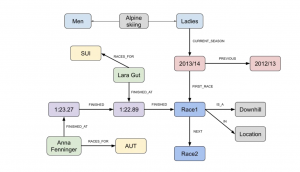
Do you know about our GraphGists? If you’re a Neo newbie, you likely haven’t encountered them before. Dozens of them have been created over the years, and they cover a wide range of industries and use cases, from pop culture and education, to sports and science, to investigative journalism, and beyond. Way beyond.
So what exactly are GraphGists? Spawned from the intrepid minds of Neo4j nodes everywhere, GraphGists are teaching tools for developers and showcase “Use case and industry specific graph examples designed to inspire you towards your Graph epiphany.”
Anyone with an idea worth exploring is welcome to submit a GraphGist to share with the Neo4j Community. The GraphGist portal will show you the way.
So we’re creating this column to regularly highlight some of our favorites from over the years, to give our readers even more proof that, yes, GRAPHS ARE EVERYWHERE.
To kick it off, let’s take it all the way back to 2014. With ski season in full swing – and the Beijing Olympics still hovering in our collective rearview mirror – it seems a fitting time to share this one. We’re going to show you how community member pac_19 used Cypher to deconstruct the results of the women’s alpine ski races in advance of the Sochi 2014 Winter Olympics.

Extracting data from the International Ski Federation (FIS), he/she then imported it into Neo4j and ran queries to connect the athletes, the season, and the races (including the location and type). Voila! The outcome is a graph that stores the results of alpine skiing races.
Check out the step-by-step replay to see a fun example of how graph technology makes the world more connected.
#GraphGist: FIS Alpine Skiing Seasons
Create a GraphGist Now



